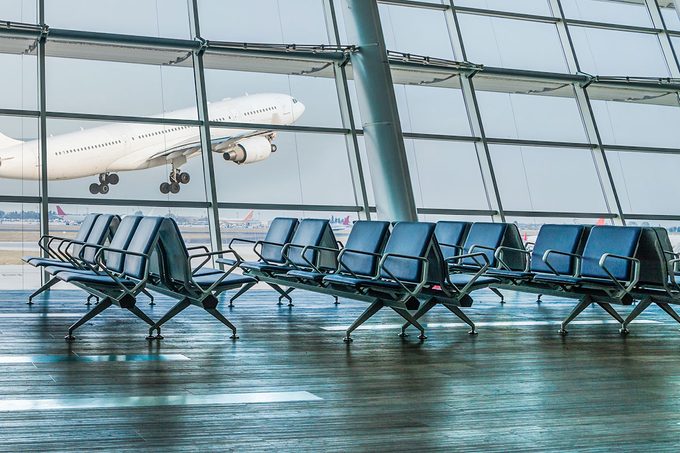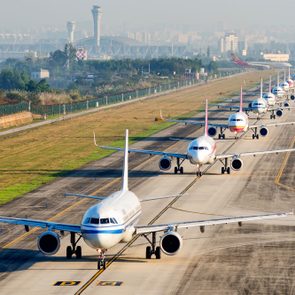Those seats aren't anchored to stop thieves—instead, it's actually all about keeping one thing under control

This Is the Surprising Reason Airport Gate Seats Are Bolted to the Ground

Many airports (looking at you, LaGuardia in New York City) have thankfully gone from the punchline of bad travel jokes to points of civic pride. But even in the most modern, newly renovated terminals, you’ll still spot seats bolted firmly to the floor. The reason isn’t just a relic from the days when terminals resembled dodgy bus stations. As times—and airports—evolve, so does their seating, though some things stay put. Reader’s Digest took a closer look at why even in the shiniest new terminals, seating is still often anchored in place. Read on to find out more.
Get Reader’s Digest’s Read Up newsletter for more travel, tech, cleaning, humor and fun facts all week long.
Are all seats bolted down at airports?
“Not all airport seats are bolted to the floor, but the bolted ones are most commonly found in hold-room areas,” or gate boarding lounges, notes Jorge Barrero, principal and regional design director at HKS, a global architecture and design firm with extensive experience in airport seating design. “The most common seat types that may be bolted down are row seats, otherwise known as ‘beam’ seating—but other larger seat types may also be secured to the floor.”
Why are so many airport seats bolted down?
The main reason seats are bolted down is to ensure passengers can move through the terminal as easily and safely as possible. “Some seats may be bolted to the floor to maintain adequate circulation between them and prevent people from moving them,” says Barrero. “It also helps to maintain consistency and efficiency in the seating design layout in these waiting areas.”
Joe Agati Sr., founder and chairman of AGATI Furniture—a Chicago-based company specializing in designing and manufacturing furniture for airports and other public spaces—adds that “pathways need to be kept clear with a minimum width of 36 inches” to comply with the Americans with Disabilities Act (ADA). “If chairs slid, or were moved, they could block traffic or create a pinch point of less than 36 inches.”
Why else do airports bolt seating to the floor?

It’s much easier to keep the terminal tidy
While airport seating isn’t bolted down to prevent theft—most is far too large and unwieldy to haul away—there’s another key reason it’s secured in place. “Having a consistent layout [helps] with cleanability and maintenance,” Barrero says. “Depending on the floor material, the seats may be designed to facilitate ease of cleaning and provide adequate clearances for cleaning equipment.”
When seating isn’t anchored, it can lead to unintended consequences—something AGATI Furniture cleverly worked around with its lounge chairs at Tampa Airport. “Every night, cleaning crews would slide the chairs out to vacuum, then slide the chairs back,” says Joe Agati Jr., the company’s COO and director of design. Over time, the chairs started to drift into the aisle walkways. The solution? In 2014, AGATI designed a metal horseshoe-like bracket that was bolted to the ground. The chair legs could slide into it, keeping them locked in place. “It was kind of like putting an X on the floor so they would know exactly where to put the chair back each time,” Agati Jr. notes. “They wanted the best of both worlds—they wanted it to be bolted down, and they wanted to be able to move it too.”
It helps airports pay for costly upgrades
Securing seats can really pay off—literally. “What a lot of people don’t know is that bolting seating to the floor allows [airports] to access federal grant funds to pay for the seating,” Agati Sr. says. Beret Ek, director of aviation business at Agati Furniture, explains that the FAA, which oversees the Airport Improvement Program (AIP), states in its handbook that “items eligible for grant money (in non-revenue-generating public spaces) need to be ‘fixed.'” Once they are, she explains, “they become a permanent fixture of the airport.”
Is bolted seating on its way out at airports?
Just like home decor, airport design is undergoing a transformation—and the results are surprisingly pleasant. According to Barrero of HKS, seating is changing significantly in most new terminals and those that are undergoing renovations. “There is a shift to provide a much wider variety of seating types to accommodate the various needs of travelers,” he says. “The seats a family on vacation would prefer would differ from those of a business traveler trying to get work done while waiting to board a flight.”
In a recent concourse expansion at Gerald R. Ford International Airport in Grand Rapids, Michigan, HKS incorporated a range of seating options. “There are a few ‘beam’ seats, benches, working tabletops and individual comfort seats,” Barrero says. “The goal was to design a space that met the seating requirements while letting passengers experience a seating area that was more lounge-like and comfortable.”
Agati Sr. sees this move toward more welcoming, adaptive furniture as an important step in the right direction. “Airports can be high-stress environments because travelers have to go through checkpoints, be on time and navigate to the right areas,” he says. “Having a comfortable place to sit decreases that tension. You feel like you have landed somewhere—especially when you’re in a bigger, more VIP-lounge-type seat where you’re encompassed like a hug, instead of bumping elbows with a stranger next to you.”
How do airports ultimately decide what seating to use?
Most passengers never give a second thought to how many seats are available—or whether they’re bolted down—but for airport designers, it’s a complex puzzle. Several factors go into making those decisions, starting with how many people are expected to use a given space, particularly in waiting areas near boarding gates. “Planning the seating areas in these spaces often requires a certain number of seats to be provided, given the number of people expected to be waiting to board a specific aircraft,” Barrero says. “Once that number is established and met, the boarding method is considered to design the most efficient layout that is flexible over time in case change is needed.”
RELATED:
- New Study: If You Fly Out of This Airport, Be Prepared to Wait Around 50 Extra Minutes Before Takeoff
- You’re Spending a Lot More at the Airport Than You Think—Here’s How Much
- The New Gen Z Travel Trend You Won’t Want to See at the Airport
About the experts
|
Why trust us
Reader’s Digest has published hundreds of travel stories that help readers explore the world safely, easily and affordably. We regularly cover topics such as the best places to visit (and the best times to visit them), tips and tricks to zoom through airport security, flight-attendant secrets, hotel-room hacks and more. We’re committed to producing high-quality content by writers with expertise and experience in their field in consultation with relevant, qualified experts. We rely on reputable primary sources, including government and professional organizations and academic institutions as well as our writers’ personal experiences where appropriate. We verify all facts and data, back them with credible sourcing and revisit them over time to ensure they remain accurate and up to date. Read more about our team, our contributors and our editorial policies.
Sources:
- Jorge Barrero, Principal and Regional Design Director at HKS; email interview, May 2025
- Joe Agati Sr., Founder and Chairman of AGATI Furniture; email interview, May 2025
- Joe Agati Jr., COO and Director of Design at AGATI Furniture; email interview, May 2025
- Beret Ek, Director of Aviation Business at AGATI Furniture; email interview, May 2025
- Federal Aviation Administration: AIP Handbook, “What Projects Can Be Funded?“



